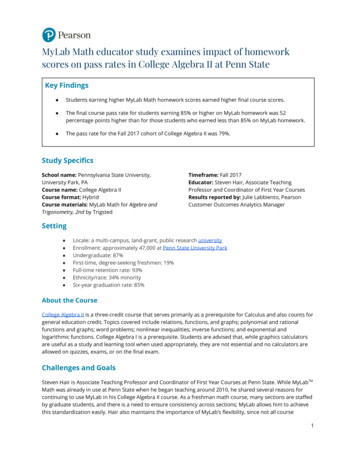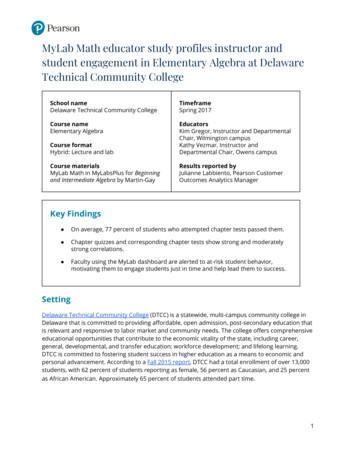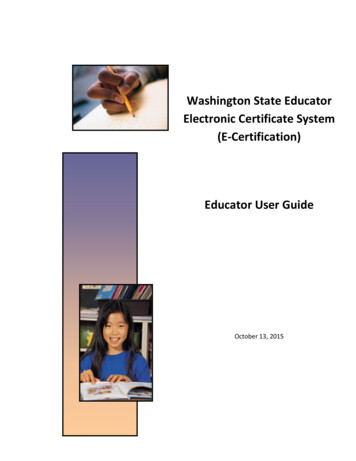
Transcription
MyLab Math educator study examines impact of homeworkscores on pass rates in College Algebra II at Penn StateKey Findings Students earning higher MyLab Math homework scores earned higher final course scores. The final course pass rate for students earning 85% or higher on MyLab homework was 52percentage points higher than for those students who earned less than 85% on MyLab homework. The pass rate for the Fall 2017 cohort of College Algebra II was 79%.Study SpecificsSchool name: P ennsylvania State University,University Park, PACourse name: College Algebra IICourse format: H ybridCourse materials: M yLab Math for Algebra andTrigonometry, 2nd by TrigstedTimeframe: F all 2017Educator: S teven Hair, Associate TeachingProfessor and Coordinator of First Year CoursesResults reported by: Julie Labbiento, PearsonCustomer Outcomes Analytics ManagerSetting Locale: a multi-campus, land-grant, public research u niversityEnrollment: approximately 47,000 at P enn State University ParkUndergraduate: 87%First-time, degree-seeking freshmen: 19%Full-time retention rate: 93%Ethnicity/race: 34% minoritySix-year graduation rate: 85%About the CourseCollege Algebra II is a three-credit course that serves primarily as a prerequisite for Calculus and also counts forgeneral education credit. Topics covered include relations, functions, and graphs; polynomial and rationalfunctions and graphs; word problems; nonlinear inequalities; inverse functions; and exponential andlogarithmic functions. College Algebra I is a prerequisite. Students are advised that, while graphics calculatorsare useful as a study and learning tool when used appropriately, they are not essential and no calculators areallowed on quizzes, exams, or on the final exam.Challenges and GoalsSteven Hair is Associate Teaching Professor and Coordinator of First Year Courses at Penn State. While MyLab TMMath was already in use at Penn State when he began teaching around 2010, he shared several reasons forcontinuing to use MyLab in his College Algebra II course. As a freshman math course, many sections are staffedby graduate students, and there is a need to ensure consistency across sections; MyLab allows him to achievethis standardization easily. Hair also maintains the importance of MyLab’s flexibility, since not all course1
assessments are delivered in MyLab. Finally, he appreciates how the content in MyLab aligns with the coursetextbook, so that students see them as a cohesive pair of study tools.ImplementationPenn State’s College Algebra II course is offered in a hybrid format, combining two days of classroom lecturewith one day in a computer lab. All sections are taught on campus; there are no online sections. The courseutilizes weekly homework in MyLab as well as quizzes, lab activities, two midterm examinations, and acomprehensive final exam. The course serves around 600 students each semester and sections are oftentaught by graduate students, so assessments are standardized, not only to ensure consistency in delivery andgrading, but also to alleviate the graduate students’ stress of creating assignments and exams on their own.Hair uses the coordinator course feature in MyLab to create identical homework shells for each section of thecourse.Homework: H air is an advocate of using digital homework systems for lower-level courses such as CollegeAlgebra II. He finds that questions in courses at this level are generally easy for a computer to grade, usuallyhaving little to no partial credit or responses that would require instructor interpretation. Above all, he feelsthat the instant feedback afforded by using MyLab Math is especially important. “When students are learning atthis level, I don’t want them to do homework incorrectly [on paper], then turn it in and not find out what theydid wrong until the following week,” he says.During the first two class periods of the week, traditional lectures are delivered by the instructors or graduatestudents, aligning to weekly homework assignments in MyLab. Students have unlimited attempts to earn themaximum number of points on each homework assignment before their due date on Tuesday of the weekfollowing the associated lecture. Late homework is only accepted by permission of the instructor. No minimumhomework score is required.Another feature of MyLab that Hair uses for this course is the set of l earning aids available in the homeworkassignments. He keeps all learning aids turned on in all of the homework assignments, including View anExample and Help Me Solve This, noting, “It is often hard to get students to read the text at this level, and thelearning aids help fill this gap. I like that the MyLab homework problems are tied directly to the textbook andthat students can click in to the eText right from the problem if they need to. And having the learning aids rightthere when they’re working on a problem makes them look at the examples a little more, as well.” When askedon a voluntary survey for their opinions on the learning aids, many students responded favorably, with onesaying, “[Help Me Solve This gives me] the opportunity to try a similar problem and receive full credit for theproblem, boosting my grade and not negatively impacting it.” Another student shared, “The different toolsavailable to you while doing homework were so helpful.”Quizzes and lab activities: D uring the third class period of the week, students attend class in a computer lab.This lab time is not intended to be spent on homework assignments. Rather, students either take proctoredquizzes on the covered material or they work on lab activities that are designed to give them the chance tomore deeply explore the algebra covered in the lecture. All quizzes and lab activities are standardized across allsections of the course.Examinations and final exam: Two 75-minute, 100-point midterm examinations are given during the courseof the semester. All students take their midterm exams at the same time on campus. These multiple-choiceexams are taken on Scantron forms and cover the lecture content up to that point. A 150-pointcomprehensive multiple-choice final exam is also given at the end of the semester. No textbooks, notes, orcalculators may be used on any of the exams.2
Assessments 200 points150 points75 points75 pointsExaminations (2)Final examination (comprehensive)Quizzes and lab activitiesMyLab homeworkGrades are assigned on the basis of 500 points. No extra credit is available in the course.Final course grades are assigned as follows:A (460–500 points) A- (450–459 points) B (440–449 points) B (410–439 points) B- (400–409 points)C (390–399 points) C (350–389 points) D (300–349 points) F (0–299 points)Results and DataOver the years, Hair has tried different approaches to using homework in the course, including allowing onlythree attempts on each assignment instead of unlimited attempts, and incorporating the MyLab Study Plan asan additional source of required, but ungraded, practice for students. He ultimately determined that addingmore assessments seemed to increase the complexity of managing and keeping up with them for both thestudents and the instructors, without presenting obvious improvements in student outcomes. He decided toadopt the current practice regimen of homework with unlimited attempts before the due date, in hopes offinding balance while providing the necessary rigor to achieve success. To that end, the pass rate for the Fall2017 cohort of College Algebra II ( n 571) was 79%, which pleases Hair.An analysis of MyLab homework scores and final course scores (figure 1) shows a moderately strong correlationbetween the two assessments ( r 0.58, p 0.0001). It should be noted that homework contributes 15% towardsfinal grades, which may impact this relationship. A correlation measures the strength of a relationship betweentwo variables, where r is the correlation coefficient. The closer a positive r- value is to 1.0, t he stronger thecorrelation. The corresponding p - value measures the statistical significance or strength of the correlation,where a p - value 0.0001 shows the existence of a positive correlation between these two variables. Note thatcorrelation does not imply causation; it is simply a measure of the strength of the relationship.Correlation between MyLab homework scores and final course scoresFigure 1. Correlation between MyLab Homework Scores and Final Course Scores ( n 571)3
Further analysis revealed more about the impact of students’ homework scores on final course scores. Figure 2illustrates the pass rates associated with students who earned homework averages falling into five ranges:90–100%, 80–89%, 70–79%, 60–69%, and 0–59 %. The data show that each ten percentage point increase inhomework scores is associated with an average 20 percentage point increase in the course pass rate, with thegreatest jump between the 70–79% and 80–89% ranges.Course pass rates by MyLab homework averageFigure 2. Course Pass Rates by MyLab Homework Average ( n 571)A deeper analysis using a t -test assuming equal variances centered on this result. Figure 3 shows the finalcourse pass rate for students earning 85% or higher on MyLab homework (M 79%, SD 99%, N 470) was 52percentage points higher than for those students who earned less than 85% on that assessment (M 63%,SD 139%, N 101), t( 569) 13.67, p 0.05.Impact of MyLab homework on course pass ratesFigure 3. Course Pass Rates Based on MyLab Homework Average of 85–100% ( n 470) and 0–84% ( n 101)4
The Student ExperienceIn an anonymous, voluntary survey given to students at the beginning of the Fall 2017 semester (35% responserate), students self-reported the following demographic information: 75% of students were in their first semester at Penn State83% of students graduated high school in 201768% of students were taking the College Algebra II course either because it was required for theirmajor or as a prerequisite for the Calculus course32% of students were taking the course to fulfill a general education requirementStudents were also asked to complete an anonymous, voluntary, end-of-semester survey in Fall 2017 (13%response rate) to share their perspectives on the course and MyLab Math. Below are selected responses:How has MyLab Math impacted your learning in your course? “MyLab has helped me understand the concepts of problems and has showed me step by step on how toperform a problem and go about the right way of doing it. This helped me tremendously prepare for testsand quizzes especially by the amount of practice problems we were given.” “The repeated exercises and teaching methods online are very helpful to supplement what I do in class.” “The practice problems increase with difficulty as I get better so I’m constantly challenged.“What do you feel are the benefits of using MyLab Math? “When I could look at other problems and if I still did not understand, I could have help solving the problemso next time around I can do it by myself.” “Definitely the tools/options to help you through a problem and show you the steps.” “It's very accessible. I loved being able to do my homework at any point, anywhere.”ConclusionIn teaching and coordinating a large freshman-level course taught largely by graduate students, Steve Hair usesMyLab Math to keep the content and homework assignments standardized and to provide the students withinstant feedback and additional resources, such as links to the eText and learning aids on each exercise. Resultsshow that students who performed better on homework earned higher final grades. Hair says, “MyLab hasbeen the best [digital homework program] I’ve been able to find in terms of flexibility to do what I want it to do.”5
Penn State's College Algebra II course is offered in a hybrid format, combining two days of classroom lecture with one day in a computer lab. All sections are taught on campus; there are no online sections. The course utilizes weekly homework in MyLab as well as quizzes, lab activities, two midterm examinations, and a comprehensive final e.










